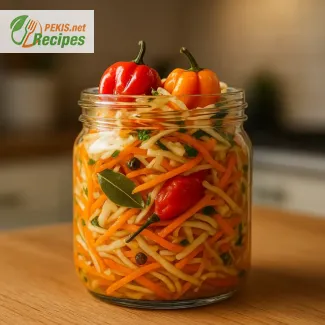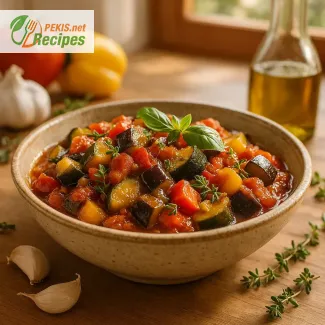
Discover the Cool Charm of Traditional Spanish Gazpacho
A Refreshing Tomato-Based Classic from the Heart of Andalusia
When the sun blazes overhead and the heat of summer seems relentless, there’s one dish that captures the spirit of southern Spain like no other – Andalusian gazpacho. This cold tomato soup, originally born in the Andalusian region, is more than just a culinary delight. It’s a celebration of seasonal vegetables, Mediterranean simplicity, and cool refreshment all in one bowl. Made with ripe tomatoes, cucumbers, peppers, garlic, and extra virgin olive oil, this traditional dish has endured for centuries because of its bold flavor and healthful character.
What Makes Andalusian Gazpacho So Unique?
Gazpacho Andaluz is not just a chilled soup; it is a sensory experience built on freshness. Its texture is silky, its color a vibrant red-orange, and its taste a balance of acidity, sweetness, and earthiness that only ripe tomatoes and fresh produce can provide. Unlike other soups, gazpacho is never cooked. The vegetables are blended raw, preserving their nutrients and delivering a refreshing intensity that's perfect for hot weather meals.
Rooted in peasant traditions, this dish once offered a way to use up stale bread and overripe produce. Over time, it evolved into a gastronomic symbol of Andalusia, served in everything from rustic homes to modern Michelin-starred restaurants across Spain.
The Key Ingredients Behind Every Spoonful
The authenticity of gazpacho Andaluz hinges on a handful of simple yet high-quality ingredients. Ripe tomatoes are the undisputed star, providing a rich umami base. Cucumbers add a cooling crispness, while green bell peppers introduce a subtle bitterness that complements the sweetness of the tomatoes. Garlic brings depth, and extra virgin olive oil lends body and a velvety finish. A splash of sherry vinegar offers brightness, while a pinch of salt ties it all together.
This vegan-friendly dish requires no animal products, making it ideal for those following plant-based or dairy-free diets. It’s naturally gluten-free if bread is omitted or replaced with a gluten-free alternative, though traditional recipes include stale white bread for body.
The Art of Serving Gazpacho: Temperature and Presentation
To truly enjoy the essence of authentic gazpacho, temperature is everything. This soup must be served ice-cold, allowing the bold, raw flavors to fully shine. It's traditionally poured into small glasses or bowls and enjoyed as a starter, light lunch, or even a drinkable snack.
Garnishes matter too. Diced cucumber, chopped red peppers, croutons, or even a drizzle of extra virgin olive oil can transform a simple bowl into a textural and visual delight. For a modern twist, some chefs top gazpacho with microgreens, crushed almonds, or a dollop of avocado purée.
Cultural Significance and Seasonal Popularity
Gazpacho is a culinary icon that goes beyond nourishment. In Spanish culture, especially in Andalusia, it represents community, tradition, and the bounty of summer gardens. It’s often made in large batches, shared among families, or brought to social gatherings during hot months.
Its popularity peaks during July and August, but with global interest in Mediterranean diets and healthy cold soups, gazpacho has found its way onto international menus and home kitchens all year round. Its minimal preparation, raw ingredients, and vibrant presentation appeal to modern tastes for clean eating, low-effort meals, and nutrient-rich recipes.
Gazpacho vs. Salmorejo vs. Ajo Blanco
For those unfamiliar with Spanish cold soups, gazpacho is sometimes confused with its cousins. Salmorejo, another Andalusian favorite, is thicker, creamier, and tomato-heavy, often served with ham and hard-boiled egg. Ajo blanco, a white garlic and almond-based soup, is milder and richer. Gazpacho stands apart with its bright acidity, light texture, and vegetable-forward profile.
Ideal Occasions to Serve Gazpacho
Whether you're planning a summer picnic, a tapas night, or a light lunch, gazpacho Andaluz fits effortlessly into any meal plan. It can be enjoyed as a standalone dish or as part of a larger spread with Spanish tortillas, olives, and fresh bread. It also pairs beautifully with grilled seafood or chilled white wines, especially dry sherry or Albariño.
Its adaptability makes it perfect for both casual and elegant dining. You can serve it in shot glasses for appetizers, bowls for lunch, or even pour it into thermoses for outdoor meals.
A Dish That’s as Nutritional as It Is Beautiful
While we’ll explore its nutritional values in depth later, it’s worth noting that gazpacho is naturally packed with vitamins, antioxidants, and hydrating elements. It supports digestive health, immune function, and overall hydration—making it an excellent choice for health-conscious eaters and those wanting to beat the heat with flavor and function.
This timeless Andalusian specialty proves that with the right ingredients, a dish can be both satisfying and invigorating, perfect for those long, sun-filled days when cooking feels too heavy.
- Prepare the vegetables: Rinse the tomatoes, cucumber, and green bell pepper. Peel the cucumber and remove seeds if desired. Cut all vegetables into chunks.
- Soak the bread: Tear the stale white bread into pieces and soak in a small bowl with a bit of water until softened (about 5 minutes).
- Blend: In a blender or food processor, combine tomatoes, cucumber, bell pepper, garlic, soaked bread, olive oil, vinegar, cold water, and salt. Blend until the texture is smooth and creamy.
- Strain: For a finer consistency, strain the blended soup through a fine mesh sieve or cheesecloth into a large bowl or pitcher.
- Chill: Refrigerate the gazpacho for at least 2 hours (preferably longer) until very cold.
- Serve: Stir before serving. Pour into bowls or glasses and garnish optionally with diced cucumber, red pepper, croutons, or a drizzle of olive oil.
Enhance the Flavor and Texture of Traditional Gazpacho
Expert Tips to Elevate Your Andalusian Cold Soup Experience
Andalusian gazpacho is already a refreshing and wholesome dish, but small adjustments can take it from traditional to extraordinary. Whether you're preparing this soup for a summer gathering or looking to make it part of your weekly routine, understanding how to refine the recipe can dramatically improve both taste and nutrition. From selecting better ingredients to using advanced techniques, the following strategies are designed to help you achieve a richer, more vibrant gazpacho at home.
Choosing the Right Tomatoes Makes All the Difference
The base of any authentic gazpacho is ripe tomatoes. But not all tomatoes are created equal. For the most intense and sweet flavor, opt for heirloom or vine-ripened tomatoes with a deep red color and slightly soft texture. Avoid watery or underripe varieties, which can dilute the flavor. Blanching the tomatoes and removing their skins before blending can lead to a smoother texture, especially if you're not planning to strain the soup.
The Olive Oil You Use Matters
Extra virgin olive oil is not just a fat in this recipe—it’s a flavor. The richness, slight bitterness, and peppery finish of a high-quality Spanish or Italian olive oil can elevate the final taste significantly. To add silkiness to your gazpacho, slowly drizzle in the oil while blending to create a light emulsion. This not only enhances mouthfeel but also stabilizes the soup, preventing separation when chilled.
Upgrading the Vinegar for a Balanced Bite
Traditional recipes call for sherry vinegar, and for good reason. Its slightly nutty, complex acidity brings out the natural sweetness of the vegetables without overpowering them. However, if you're out of sherry vinegar, red wine vinegar with a touch of balsamic can be a suitable substitute—just use sparingly to maintain the right balance.
Adjusting Bread to Control Thickness
Stale bread is often added to thicken the soup and create a creamier consistency. However, the type and amount of bread can dramatically affect the final result. Using day-old sourdough or ciabatta gives a more complex, tangy background, while whole grain bread introduces nuttiness and fiber. For a lighter version, reduce the bread or replace it with a small amount of soaked oats or cauliflower florets—both of which add body without gluten or extra carbs.
Adding Depth with Roasted Garlic or Shallots
While raw garlic offers a spicy punch, some palates may find it overpowering. For a more mellow and sophisticated taste, try using roasted garlic, which adds sweetness and umami. Similarly, blending in a small amount of roasted shallot can enhance the soup's depth and make the flavor more layered and complex.
Don’t Skip the Straining for Velvet-Smooth Texture
A common mistake with homemade gazpacho is skipping the straining step. Even with powerful blenders, tomato seeds and pepper skins can create a slightly grainy texture. Passing the mixture through a fine mesh sieve or nut milk bag removes any pulp and ensures a luxuriously smooth finish, especially when serving guests or presenting the dish as an appetizer.
Chill Time Is Crucial for Flavor Development
While gazpacho can be consumed immediately after blending, it improves drastically after 2 to 4 hours in the fridge. Chilling not only brings out the flavor clarity but also allows the ingredients to marry and mellow, creating a more cohesive dish. To deepen the cold effect, serve the soup in pre-chilled bowls or glasses.
Elevate Garnishing for Flavor and Visual Appeal
Traditional toppings like diced cucumber, bell pepper, and croutons add texture and freshness. However, consider additions like:
- Chopped green apple for a sweet-tart crunch
- Toasted almonds for nutty contrast
- Fresh basil or mint to enhance herbal notes
- Avocado slices for creaminess and healthy fats
These elements add not only texture but also visual dimension, making the dish more appealing and satisfying.
Common Mistakes to Avoid in Homemade Gazpacho
- Over-blending: This can heat the mixture and change the flavor. Always blend in short bursts and chill immediately.
- Too much garlic: A little goes a long way; use restraint or roast it for balance.
- Under-seasoning: Gazpacho needs adequate salt and acid to avoid tasting flat.
- Serving too warm: Always refrigerate thoroughly; lukewarm gazpacho loses its refreshing edge.
Healthier Alternatives Without Compromising Taste
Gazpacho is already a low-calorie, plant-based soup, but it can be made even healthier:
- Replace bread with zucchini or carrot purée for fiber and sweetness
- Use coconut vinegar or apple cider vinegar for alternative acids
- Add a small handful of spinach or kale to the blend for a nutrient boost—these greens subtly enhance color without altering taste significantly
- Substitute some of the tomato with red watermelon to add a fruity dimension and increase hydration
Why Homemade Gazpacho Is Always Better
Store-bought versions often contain stabilizers, preservatives, or excessive salt. Homemade gazpacho allows you to control every ingredient, adjust for dietary needs, and create a soup that reflects freshness and purity. More importantly, blending the vegetables yourself ensures that you're maximizing the presence of live enzymes, vitamins, and natural flavors without compromise. Homemade preparation also allows room for creative variation—making it not just a meal, but a signature dish tailored to your kitchen.
Allergens present in the recipe:
- Gluten (from stale white bread)
Substitution tips to remove allergens and gluten:
- Use gluten-free stale bread or gluten-free rolled oats as a thickener.
- Ensure vinegar is gluten-free certified, especially for sensitive individuals.
Vitamins and minerals per serving (approximate):
- Vitamin C: 45 mg – supports immune function and skin health
- Vitamin A: 950 IU – promotes vision and skin regeneration
- Vitamin E: 1.8 mg – protects cells from oxidative stress
- Potassium: 620 mg – aids in muscle function and fluid balance
- Magnesium: 28 mg – important for nerve and muscle function
- Iron: 1.1 mg – supports red blood cell production
Antioxidants per serving (approximate):
- Lycopene: 10 mg – found in tomatoes, linked to heart and prostate health
- Beta-carotene: 1.2 mg – converted into vitamin A, supports immunity
- Flavonoids: 40 mg – present in bell peppers, anti-inflammatory effects
- Vitamin C (as antioxidant): 45 mg – neutralizes free radicals and aids collagen synthesis





